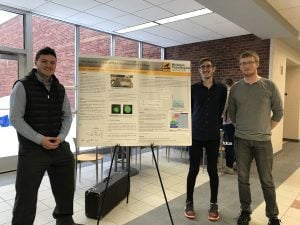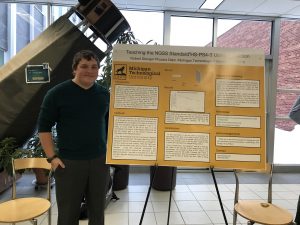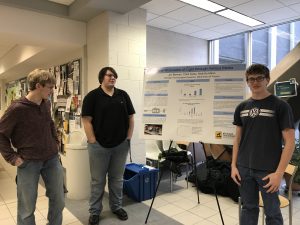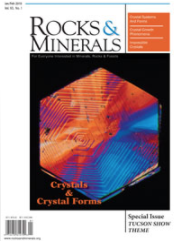Congratulations to Janarjan Bhandari (Advisor: Prof. Claudio Mazzoleni), Aeshah Muqri (advisor: Prof. Jae Yong Suh) and Kevin Waters (Prof. Ravindra Pandey), who have received Finishing Fellowships from the Graduate School.
 Raymond Shaw (Physics/EPSSI) is the principal investigator on a project that has received a $185,703 research and development grant from the National Science Foundation (NSF). Will Cantrell (Physics) is Co-PI on the project “Laboratory Studies of the Effect of Turbulence on Aerosol-Cloud Interactions.”
Raymond Shaw (Physics/EPSSI) is the principal investigator on a project that has received a $185,703 research and development grant from the National Science Foundation (NSF). Will Cantrell (Physics) is Co-PI on the project “Laboratory Studies of the Effect of Turbulence on Aerosol-Cloud Interactions.”Congratulations to Aeshah Muqri (advisor: Jae Yong Suh), who was recognized with an Outstanding Teaching Award, and Meghnath Jaishi (advisor: Ranjit Pati) who was recognized with an Outstanding Scholarship Award.
Students in PH3210 presented posters on their class projects.
Keegan Downham, Sam Groetsch, and Zack Hjorth (above, L to R) presented “The Quantum Eraser and the Brachistochrone Problem.”
Robert Stenger (above) presented “Teaching the NGSS Standard HA-PS4-3 Using Diffraction”
Chris Colby, Matt DeMario, and Jon Berman (above, L to R) presented “Power Modulation of Light through Various Media.”
A photomicrograph illustrating a growth spiral on a natural graphite crystal, taken by John Jaszczak (Physics), was published on the cover of the latest issue of Rocks and Minerals magazine (Jan/Feb vol. 93, 2018.)
Mark Kulie (GMES/EPSSI) is the principal investigator on a project that received a $8,448 research and development grant from the National Aeronautics and Space Administration (NASA). The project is “Deployment and Maintenance of a Proposed Snowfall Measurement Network to Study GFM Footprint-level Snowfall Variability.”
This is a nine-month project.
 A Frontier Review article published by Yoke Khin Yap was one of the Top 10 most downloaded articles published in Environmental Science: Nano in 2017 and was included in a feature collection showcasing the journal’s Most Downloaded Articles. This article, entitled “Water Purification: Oil-water Separation by Nanotechnology and Environmental Concerns” was co-authored by Chee Huei Lee, Bishnu Tiwari, and Dongyan Zhang.
A Frontier Review article published by Yoke Khin Yap was one of the Top 10 most downloaded articles published in Environmental Science: Nano in 2017 and was included in a feature collection showcasing the journal’s Most Downloaded Articles. This article, entitled “Water Purification: Oil-water Separation by Nanotechnology and Environmental Concerns” was co-authored by Chee Huei Lee, Bishnu Tiwari, and Dongyan Zhang.
Environmental Science: Nano is a high-impact journal published by the Royal Society of Chemistry. This journal is designated to publish articles on nanomaterial applications and interactions with environmental and biological systems.
 Salt-doped block polymers and ionic liquids—it’s a thermodynamic party. Better physics simulations crank up the possibilities for new composite materials.
Salt-doped block polymers and ionic liquids—it’s a thermodynamic party. Better physics simulations crank up the possibilities for new composite materials.
Issei Nakamura is a theoretical physicist bringing a reality check to soft materials development. Specifically, he models the complex interactions of ionic liquids and block polymers, which together create salt-doped block polymers.
The ionic liquid squishes in between all the loops and strands of the block polymer. Because an ionic liquid can assemble a block polymer into millions of structures with wide-ranging properties, the possibilities are nearly endless. The composite materials show promise for battery electrodes, fuel cell membranes, electrochemical sensors and even artificial muscles.
The catch is that the materials have to get their thermodynamic groove figured out. Right now, untwining the conditions and properties of all those possible structures is like learning to tango blindfolded. Researchers and engineers can go through the motions, but understanding the sequence, the steps—and why—requires a new way to look at the system. And that’s where Nakamura steps in. Read the full story in Unscripted.
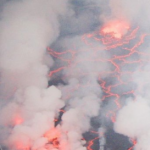 In reviewing the year’s highlights, NASA mentioned a study led by Simon Carn (GMES) that shared out the world’s first truly global inventory of volcanic sulfur dioxide emissions.
In reviewing the year’s highlights, NASA mentioned a study led by Simon Carn (GMES) that shared out the world’s first truly global inventory of volcanic sulfur dioxide emissions.
Using data from the Dutch-Finnish Ozone Monitoring Instrument on NASA’s Earth Observing System Aura satellite launched in 2004, Carn and his team compiled emissions data from 2005 to 2015 to produce annual estimates for each of 91 presently emitting volcanoes worldwide.
The dataset will help refine climate and atmospheric chemistry models and provide more insight into human and environmental health risks. Read more and watch a video on NASA’s 2017 highlights and learn about volcano breath in the Michigan Tech news story about Carn’s research.
 Ramy El-Ganainy is co-author on a paper, Non-Hermitian photonics based on parity–time symmetry, published 30 Nov 2017 in Nature Photonics (doi:10.1038/s41566-017-0031-1)
Ramy El-Ganainy is co-author on a paper, Non-Hermitian photonics based on parity–time symmetry, published 30 Nov 2017 in Nature Photonics (doi:10.1038/s41566-017-0031-1)
